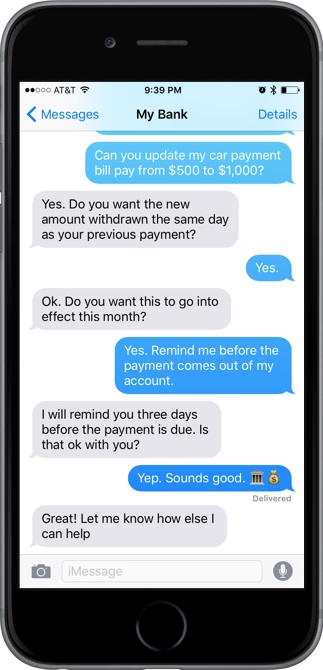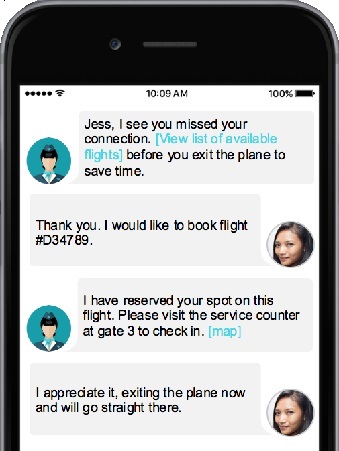by Sam Lakkundi, CIO at Kore.ai

20 Answers to Complicated Questions You’re Asking About Bots
by Sam Lakkundi, CIO at
Kore.ai


A recent article from The Verge
 asks 20 questions
about bots that I think are worth taking the time to answer. There’s a ton of
hype, but also some confusion in the market that we’d like to clear up. Bots are
not apps. Bots are not exclusive to one channel - they pick up if you call,
text, or email them. Not all bots have the capacity to go rogue. Bots won’t take
jobs, but they will empower people to do more with the time they have, helping
organizations truly gain the productivity and growth metrics they’ve been
seeking.
asks 20 questions
about bots that I think are worth taking the time to answer. There’s a ton of
hype, but also some confusion in the market that we’d like to clear up. Bots are
not apps. Bots are not exclusive to one channel - they pick up if you call,
text, or email them. Not all bots have the capacity to go rogue. Bots won’t take
jobs, but they will empower people to do more with the time they have, helping
organizations truly gain the productivity and growth metrics they’ve been
seeking.

The bot conversation is complex, promising, and it’s just ramping up. At Kore we believe that people should be able to talk to systems like they talk to each other… through the simplicity of a message and/or spoken conversation. We’re very excited to be a part of this discussion and hope the below brings much needed clarification to this disruptive emerging market.
Bots are intermediaries between systems that you can talk to. They communicate with applications, things, and people to take action on revenue generating immediately.
Let’s move into the 20 questions posed by
Dieter Bohn
 and our answers. A lengthy
post (we had a lot to say), but worth the read…
and our answers. A lengthy
post (we had a lot to say), but worth the read…
#1. How should you talk to the bot? Should you use Facebook Messenger? Skype? iMessage?
This depends on the bot vendor. Facebook bots only live in Messenger, Slack bots live in Slack. That said, if a vendor like Kore Inc. is chosen, bots are channel agnostic, meaning users can communicate with bots on a website, in SMS, email, Skype, Slack, or in the channel of choice.
- SMS
- Facebook Messanger
- Skype iOS and Watch OS
#2. Will which bots you use be completely dependent on the platforms you’ve chosen to use, just like which apps you have access to is largely driven by what kind of phone you have? Or will it be a little more open, like the web?
Bots are platform agnostic because there is no UI to design, and no UI is the new UI. Therefore, development costs are exponentially lower and time to value is much faster because you only have to maintain updates or expand bot capabilities once for all platforms.

#3. Right now, bots in my home like Alexa work slightly differently than the bots on my computer, my phone, my wrist, and my car - to say nothing of how they all work differently from each other. Will they eventually all work the same?
That depends on the NLP technology. Kore’s NLP technology is called ChatScript. These technologies have different capabilities because they were built to do different things. For example, a Kore bot will never have the “Microsoft Tay” problem because it was not built to recognize inappropriate language. It only recognizes keywords that developers “allow” it to.
WHEN TO USE A MASTER BOT, SOLUTIONS BOT, AND A CHATBOT
“WHICH BOT WILL YOU USE? IS IT A BOT OR AN “INTELLIGENT ASSISTANT?” WHAT’S THE DIFFERENCE?”
Now we are getting into the hierarchy of bots. A “chatbot” is one bot mapped to one system. A solution bot, is a combination of systems represented by one bot. For example, a sales solution bot will appear to the user as one bot… behind the scenes; however, the bot is connected to multiple systems like Salesforce, Calendar, GoToMeeting, Marketo, LinkedIn, Docusign, etc. The bot is able to recognize the language, tasks, and actions associated with each system. It helps to think of the bot as a traffic controller. Lastly, there’s the master bot. Master bot examples such as Siri, Alexa, Cortana, Kora etc. are more relevant to the “virtual assistant” analogy. These “master bots” can designate tasks and actions to the solution bots and chatbots.
#4. Is it better to type or speak to a bot?
This depends on the bot’s sophistication, the user preference, and the context of the data being sent to the bot. For example, if I’m at the airport, I would not speak to my Salesforce bot about my confidential opportunities. I would much rather message the bot to ensure data security.
#5. Should you pick an intermediary that’s (presumably) better at natural language recognition than these bots and talk to Google or Cortana or Siri? That’s how Microsoft, Google, and Apple describe how things will go. (Though with Apple, Siri works with apps, not bots, and more I have questions about that later!) You talk to their intelligent assistants, they talk to the bots for you. But you can also talk directly to bots. Which do you choose and when?
In our opinion, there is no need to talk to an intermediary bot. Apple, Microsoft, and Google developed “master bots” first. Other bot providers have chosen to build chatbots that connect to any enterprise system. Now we are getting into the difference between mobile apps and bots… (more on that later)
#6. Assuming you opt for Siri or Alexa or whatever, will those intermediaries even be able to talk to the bot you want?
This depends on your company or personal “bot store”. Ideally, you would have a chatbot for every enterprise application you need to get your job done and/or make your personal life more efficient. Siri and Alexa (or any other master bots) need a chatbot to talk to the enterprise application you are communicating with.
#7. If I’m talking to an intermediary in most cases, does it make sense for bot makers to invest in figuring out how to understand natural language and maintain context throughout a conversation? Much larger companies with vastly larger resources are pursuing the exact same thing and they’re all basically telling these bot makes not to bother, to just make dumb bots that are little more than glorified APIs. Should they do that? Is that dumb?
Loaded question… A bot is entirely less valuable if it can’t recognize user intent and understand natural language. It is absolutely necessary for companies to invest in Natural language capabilities. Using a bot that doesn’t understand your needs is frustrating and quite frankly, pretty worthless.
The value of a bot is in the data you can receive from it and take action on. Let’s take an IoT example… The Nest Thermostat is much more valuable with a bot because without a bot, it’s only a sensor. A sensor recognizes temperature, but is unable to take action or “tell” the user about the data it’s collecting. Today we have to go into an app, check the temperature, and manually lower or raise it based on our preference. A bot; however, can recognize patterns and have a conversation with you in the channel of your choice. Let’s say you leave every day at 8am for work. It’s day three of your “bot enabled thermostat” and the bot “recognizes” you turn off the air at 8am and turn it back on at 5pm. The bot sees a pattern in your behavior and can ask you if you want the air turned off everyday (or every weekday) at 8am and if you want it to turn back on when you are on your way home from work. You say yes, and your bot is set-up for as long as you want it to work that way.
I know you’re asking “What if I come home early”. Great bot use case! A truly “smart bot” has location services capabilities built in. If you leave the office at noon for some reason and start heading home, the bot can call you (since you are probably driving) and ask if you are coming home and when you want the air on. Not only is it a vast improvement in customer service, but even greater for your electric bill and energy savings.
TRUSTING A BOT (It’s All “A-Bot” Trust)
“WE’RE GOING TO BE GIVING THESE BOTS A LOT OF PERSONAL INFORMATION”
I’ll be honest, data, in the world of bots, is residing in places it never has before. While a bot can be designed to secure information via a private channel like Kore, data that’s shared in a public channel - such as Facebook or Slack - is subject to the security sensitivities of that channel. Private channels are good. Public channels aren’t secure.
While there is a lot of due euphoria surrounding bots and their potential, organizations need to pause and assess the bot and its security capabilities and management controls before jumping into the “bot pool.” As the technology becomes more popular, expect developers to restrict bot access to secure channels only - those that are encrypted and provide manage controls.
For more information on bot security read
3 Essential Tips for Enterprises to
Enhance Chatbot Security

#8. Should bot makers use Microsoft’s bot-making tool set? Facebook’s? Apple’s app toolset?
Know your vendor. Understand if they’re consumer or enterprise focused, or both and their security parameters. “Bot makers,” or developers, should build bots on a platform that offers security and encryption needed to support the enterprise and protect sensitive data and PII. The platform should enable administrators to easily build, deploy, and manage multiple enterprise bots centrally across an entire organization. As far as which of the three listed here to use, let’s just say we have an exciting announcement happening on July 13 that adds some flavor to this discussion.
#9. Do you trust either the bot or the intermediary to keep your data safe and secure?
A malicious hack or data leak is a viable possibility if proper security measures are not taken. Enterprises understand this issue and employ encryption across data channels and silos to protect data at rest and in motion. Email and SMS messages are encrypted, as well as bank messaging services and other classified services that exchange sensitive information.
When it comes to bot data access, developers and enterprises that are interested in protecting data and communications will grant bots access to only encrypted channels. Users who are attuned to the dynamics of bot security will only use bots that leverage encryption. Public bots are a different matter; businesses don’t have control over these platforms, what they encrypt and don’t encrypt, and what channels and information they access. This has the makings of a huge cybersecurity storm that can wreak havoc on those that fail to heed the consequences.
#10. Will there be a centralized “Bot Store” where you can rate and review bots? How will you figure out which ones suck and which ones don’t (and, again, which ones work with your ecosystem of choice)?
Bot providers have created their own bot stores, but arguably the most valuable bots will reside in your company’s bot store. Imagine the power of messaging SAP ERP instead of navigating a complicated interface. Imagine changing sales roles… you will never have to “learn” a new CRM system again. Bots are drastically reducing onboarding and training times, while allowing you to get back to the activities that matter most at work. Bots aren’t meant to be “another thing” you have to adopt or “do” in a day. They give you time back and that’s your most valuable resource.
#11. And really, it’s past time I asked this: Will this so-called next generation computing revolution fizzle before it can fully invade your chat apps in the first place?
At Kore, we believe bot technology is an “evolution”… not a revolution. Bots are essentially the enhancement of enterprise applications. Remember the first mobile apps? Remember the first iPhone? Look how far we’ve come in such a short period of time. We don’t need “more” on our plates, we need to maximize the systems we already have, and bots empower us to do just that.
#12. Is using a chatbot for customer service really better than using one of the many other vectors most big companies offer you, including apps, websites, complaining on Twitter, and phone support?
Let’s think about the customer service website experience for your service provider today. How long did it take you to find the “right” page? Did you find what you were looking for? How long did it take you to get someone on the phone? Did he or she solve your problem? Did someone come to your house?… I could go on and on about this use case. Bots enable businesses to eliminate the user’s need to navigate a website all together. If a true “chatbot” presented itself on a website as soon as you arrive, it can ask what you need and take you straight to the destination you’re looking for.
Now for the business side… Call center/customer service roles are faced with high turnover, long onboarding and training times, complicated user interfaces, etc. etc. A bot not only takes away the UI of these incident logging systems, but can also “listen” to the questions being asked by the customer and present suggestions to the customer service rep, allowing the rep to focus on the relationship building aspect of the call vs. frantically searching for product information and appropriately logging data.
You might be wondering how this customer service use case could possible save you money. Let me walk you through an example. We are working with a washing machine manufacturer to build a custom bot that helps people find the serial number on their washing machine before speaking with a customer service rep. This incredibly hidden serial number was causing major backups on the phones and highly frustrated customers before they even got to the problem with their machine. By communicating in the channel of the customer’s choice, the bot can guide the user to the serial number and automatically connect them with the live agent when the customer has located and entered the serial number. Time is money, and this manufacturer can save a lot of it. And by the way, customers are much happier while live agents can reach more resolutions daily.
BOT OCCUPATIONS -
These assistants won’t take your job, they’ll give it back to
you.

“IS A BOT GOING TO TAKE YOUR JOB?”
No way! A bot makes it easier for you to do your job, but a bot is not intended (nor can it) automate an entire day’s work. Example: Enabling Single Truck Roll for Service Providers with Bots

#13. How many jobs will be lost because of bots? How many will be created?
That’s like asking Steve Jobs how many apps will be created the day of the iPhone release. Put it this way, bots are easier and faster to develop which equals more possibilities, less strain on resources, and more efficiency. The more that bots can help a business grow, the more jobs will be created.
Let’s look at a manufacturing example. Bot software on a sensor/machine can tell a worker that the machine needs more screws. The machine still needs the worker to load the screws, but the supply chain is now more reliable because the machine can advise the correct person when issues are detected, therefore better preparing and protecting the business without a halt in critical processes.
#14. We’ve heard a lot about the companies making these bots hiring poets and such to help write their language. How long until jokes about English Majors actually being useful become tired?
This is not what our company is trying to do at all. Our copywriter is a genius. No bot could ever replace him. Why? Because this person is creative, unique, empathetic, and hardworking. Bots are meant to send data, take action, “learn” user behaviors, and properly source data, not become the world’s greatest tech recruiter or the next Shakespeare.
#15. So instead of talking about bots, Apple is talking about apps that can plug into iMessage and Siri. That makes perfect sense for Apple - it plays to its strengths and keeps developers beholden to Apple’s vision while simultaneously (theoretically) guaranteeing a certain level of quality inside those bot interfaces. Ok, cool. But! What, exactly, is the line between a bot and an intelligent assistant and an app?
Let’s be clear, a bot is NOT a mobile app for a couple of reasons. So, the difference between bots and mobile apps is not only time to value and cost, but also the true change that bots can bring to the way your employees, customers, and systems communicate with each other.
Let’s start with mobile apps. They are downloadable and installed, so they are using resources from your OS. What they don’t necessarily do is change the interaction with your backend systems, but they do let you access the information you want from different devices.
Bots on the other hand, are something you talk to. They are the endpoint that makes “calls” to application APIs and the NLP engine while having a conversation with the end user. I think it helps to imagine bots as the bridge to receiving actionable data from business critical systems in real time. Regarding the statement about apps that can plug into iMessage and Siri - that is not an app, that’s a bot. From an end user’s perspective, it look like you’re texting the app but in reality, you’re texting the bot associated with the app. Here’s what it looks like:

#16. And how will you know which one to use at any given time?
Personally, we believe bots will fit seamlessly into our personal and professional lives. Before mobile apps, we were tethered to desktops and laptops, even tied to the office network from 9–5. “Going mobile” has enabled the world to work remotely, see more clients, and get access to information wherever, whenever we need it. You will use a bot when the task makes sense.
For example, if you get a text from your airline letting you know you will miss your connection due to delays then asking if you want to see the options to rebook your flight, you will probably respond with an absolute yes. On the other hand, you would always use PowerPoint on a laptop or desktop - not through a bot. Common sense instinctively tells us what tasks make sense on which device, in what app, or with which bot.
Missed Your Connection? Bots Can Help

#17. As this crazy future of bots evolves, will any of these questions even be relevant or will they all seem hopelessly out of context, like asking where the rotary dial is on a touchscreen phone?
To be honest, these questions are perfect for where the market is at in understanding the bots landscape right now. The concept is not easy to grasp, especially if you haven’t seen a demo or don’t use bots already. Bots are disruptors, C-level buyers are skeptical, and early adopters are trying to figure out if and how bots will add value to our daily lives.
#18. Does anybody except developers and big tech companies even care about bots? Because, let me tell you, it sure doesn’t look like it to me right now. Are we waiting for an “iPhone moment” or an “App Store moment?”
Absolutely. Here’s why industries, especially big enterprises in retail, healthcare, financial services, manufacturing and hospitality spaces, should care. We will continue to/have to use the enterprise applications our businesses chose to run the workplace. However, trends like digital transformation and mobile are driving customers to expect more. If clients aren’t getting the customer service they expect from you, they will go somewhere else.
This also applies to a new generation of workers who are “only as faithful as their next best option.” Millennials seek their own solutions to get their jobs done better and faster, they leave if they can’t impact a business within the first year, and they create agile, innovative business models to replace the old with the new. Disruptors like Airbnb and Uber are apt to displace legacy competition while building businesses that rely on new models to operate. It’s no longer the big players that win, it’s the fast and agile.
In terms of “waiting for our iPhone and/or app store moment,” the race to be first to market is no new trend; however, the lack of product maturity for some of these major players is evident. Time will tell who gets their “iPhone” debut, but market awareness, bot definition clarification, and proof of value is needed first.
#19. Assuming it ever comes to pass, will bots be as lucrative for developers as apps are (or, you know, were)? Will there be a bot economy?
At Kore, we believe bots will be as lucrative, if not more lucrative for developers as apps because they are, again, easier to build, deploy, and use. Bot use cases are infinite, which makes the solution hard to grasp at first. They are also a combination of technologies including NLP, AI, IoT, and Machine Learning. That’s a hefty menu for a three letter word.
#20. Is it wrong for us to keep talking about the “wave” of bots that are coming?
I don’t think it’s wrong, but there is a sense of impatience in limbo land. Right now, bot agility is enabling our organization to consume tons of information while tackling some very complex use cases, but it does take time to see the fruits of bot labor. For bots to get they market recognition they deserve, they will need to mimic the Fortune 500s tech history - who will jump first, who will find lasting success, and who will identify the challenges to overcome - in order to take business to the next level.